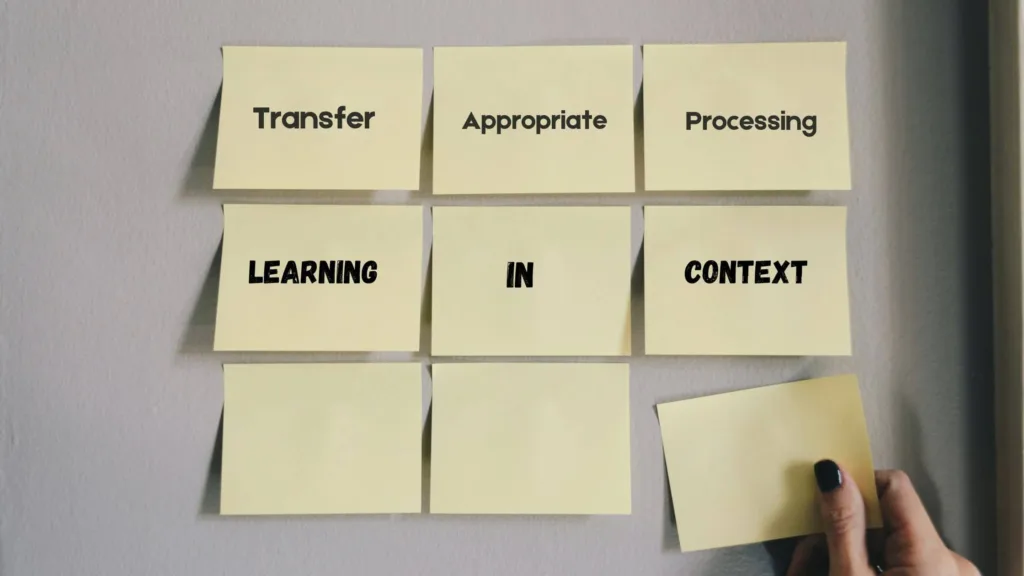Memory and learning are essential parts of how we think, helping us in our daily lives and over time. One important theory about how we remember things is called Transfer Appropriate Processing (TAP). This idea, created by Fergus Craik and Robert Lockhart in the 1970s, says that how well we remember something depends not just on how deeply we think about it, but also on how similar the way we learn it is to the way we try to remember it later.
Understanding Transfer Appropriate Processing
Transfer Appropriate Processing is based on the idea that we remember things better when the way we learn them is similar to the way we try to remember them. This means that if we use the same mental steps when learning and recalling information, we’ll have an easier time remembering it.
For example, imagine you are studying for a spelling test. If you practice spelling words by writing them down, you are likely to remember them better when you have to write them down again during the test. On the other hand, if you only practiced by saying the words out loud, you might not do as well on the written test because the way you learned the words (speaking) is different from how you need to remember them (writing).
Key Principles of TAP
- Process Specificity:
The way you learn something should be similar to the way you’ll need to remember it. For example, If you learn by listening (like hearing a lecture), you’ll remember better when you hear something similar again (like listening to a related question). Your brain gets used to processing the information in a specific way (through listening), so it’s easier to recall in the same way.
- Task Relevance:
The type of practice you do should match what you’ll be tested on. For example, If you’re preparing for a math test, practicing solving math problems is more effective than just memorizing formulas. Solving problems is the same kind of task you’ll do on the test, so this practice helps you get better at the actual test activities.
- Encoding-Retrieval Match:
The place and situation where you study should be similar to where you’ll need to remember the information. For example, if you study in a quiet room and your test will be in a quiet room, you’ll remember better because the two settings are alike. Your brain finds it easier to retrieve information when the study environment and the test environment are similar.

Practical Applications of TAP
Transfer Appropriate Processing (TAP) can help improve memory and learning in many everyday situations. Here are some simple examples of how you can use TAP:
- Studying and Schoolwork:
- Preparing for Tests: Study in a way that matches the test format. If your test has multiple-choice questions, practice with multiple-choice questions. If it includes essays, practice writing essays.
- Class Activities: Teachers can create activities that are similar to test conditions. For example, if a test will be taken in a quiet room, practice in a quiet room.
- Learning Subjects: For subjects like math, practice solving problems because that’s what you’ll do on the test. This is better than just memorizing formulas.
- Learning Skills and Training:
- Sports Practice: Athletes should practice in conditions that are like real competitions. For example, a basketball player should practice shooting in a noisy gym to simulate a game.
- Music Practice: Musicians should practice their pieces the same way they will perform them. For example, a pianist should practice on the same type of piano they’ll use in a concert.
- Job Training:
- Simulations: Employees can practice their jobs using simulations that mimic real tasks. For example, customer service reps can practice role-playing exercises that are like real customer calls.
- Real-World Practice: New employees should train in the actual work environment to get used to the specific tools and situations they’ll encounter.
- Everyday Memory Tips:
- Remembering Names: Use someone’s name in conversation right after meeting them to help remember it later.
- Shopping Lists: Instead of just writing a list, imagine walking through the store and picking up each item. This makes it easier to remember what you need once you’re in the store.
- Technology and Learning Tools:
- Educational Apps: Use apps that offer practice activities similar to real-world tasks. For example, language learning apps that include speaking and listening exercises help prepare for real conversations.
- Virtual Reality (VR) Training: VR can create realistic learning experiences, like medical students practicing surgeries in a virtual operating room.
Related Info: Reconstructive Memory: Piecing Together the Past
Transfer Appropriate Processing (TAP) helps us understand memory better by showing how important it is for the way we learn something to match the way we remember it. Studies support this idea, and it can be used in many areas like education and training. By making sure the learning and remembering situations are similar, TAP helps improve memory. This makes TAP a useful theory in understanding how we think and learn.

Pingback: Phonological Loop: Your mental voice recorder
Pingback: Positive Transfer vs Negative Transfer in Psychology